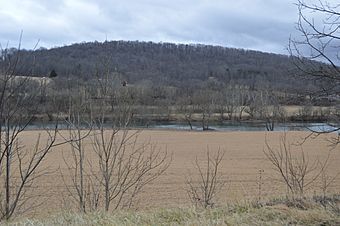Martin Site (Fosters Falls, Virginia) facts for kids
The Martin Site (also known as 44WY13) is a very old Native American village site in Wythe County, Virginia, United States. It sits right on the banks of the New River, close to a place called Fosters Falls. This site shows clear signs that people lived there during the Late Woodland period, which was a long time ago. It also has clues that people lived there even earlier.
Archaeologists have found many interesting things at the Martin Site. These include pieces of pottery, tools made from stone, and items made from shells and ceramics that were traded. They also found ancient burial sites.
Contents
Discovering the Martin Site
The Martin Site is located on the flat land next to the New River. This area is covered by deep layers of river mud and sand, called alluvium. For many years, farmers grew crops on this land. However, the river deposits were so deep that their plows never reached the old village site below.
The site was found by accident in May 1970. The landowner, William Martin, was building a campground. While digging to put in a septic tank, he found human bones. Local police quickly realized these were very old bones from a prehistoric site. An archaeologist from Richmond came within a few days to look at the area. Digging to explore the site officially began in July of that year.
Who Lived at the Site?
Archaeologists found many projectile points (which are like arrowheads or spear tips) from the Late Archaic and Early Woodland times. This suggests that people used this site for a very long time.
The site was most busy during the Late Woodland period. At that time, the Dan River culture lived there. Their village likely had many round houses. These houses might have been surrounded by a palisade, which is a fence made of strong wooden posts for protection.
Most of the items found at the site belong to the Dan River culture. This includes more than sixteen thousand sherds, which are broken pieces of pottery. Scientists used a method called radiocarbon dating on some items. This showed that some of the earlier cultures were present around 1440 BC.
What Was Found?
Besides the human bones found by the owner, many animal bones were also discovered. Deer bones were the most common. There were also many shells from mollusks that live in the New River. These included clams, mussels, and Polygyra periwinkles.
No trade goods from Europeans were found at the site. This means that people likely stopped living there before the year 1600. The Martin Site might have been used at the same time as the Cornett Site. The Cornett Site is about 6 miles (10 km) west, near Austinville.
A Protected Historical Place
Because of its importance, the Martin Site was added to the National Register of Historic Places in 1974. This helps protect the site and its history for future generations.


